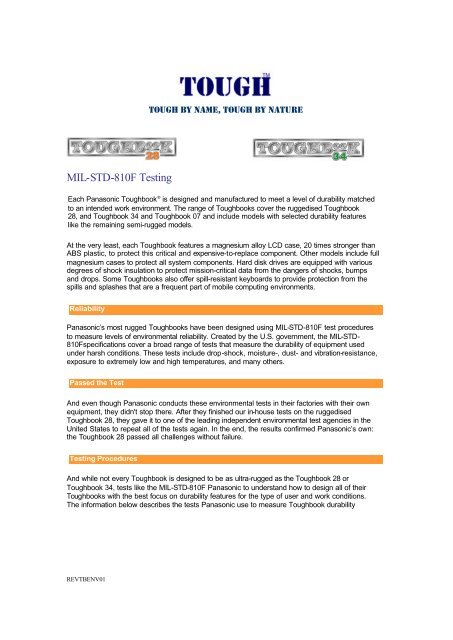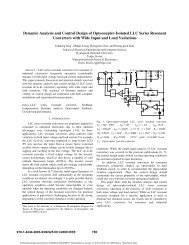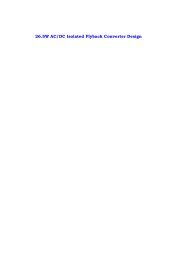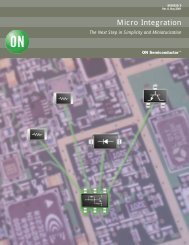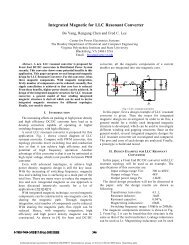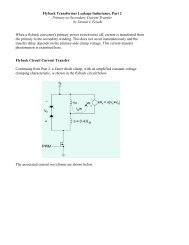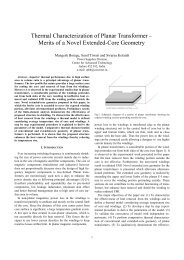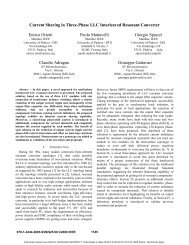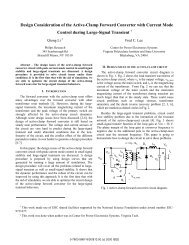MIL-STD-810F Testing
MIL-STD-810F Testing
MIL-STD-810F Testing
You also want an ePaper? Increase the reach of your titles
YUMPU automatically turns print PDFs into web optimized ePapers that Google loves.
TOUGH By Name, TOUGH By Nature<strong>MIL</strong>-<strong>STD</strong>-<strong>810F</strong> <strong>Testing</strong>Each Panasonic Toughbook ® is designed and manufactured to meet a level of durability matchedto an intended work environment. The range of Toughbooks cover the ruggedised Toughbook28, and Toughbook 34 and Toughbook 07 and include models with selected durability featureslike the remaining semi-rugged models.At the very least, each Toughbook features a magnesium alloy LCD case, 20 times stronger thanABS plastic, to protect this critical and expensive-to-replace component. Other models include fullmagnesium cases to protect all system components. Hard disk drives are equipped with variousdegrees of shock insulation to protect mission-critical data from the dangers of shocks, bumpsand drops. Some Toughbooks also offer spill-resistant keyboards to provide protection from thespills and splashes that are a frequent part of mobile computing environments.ReliabilityPanasonic’s most rugged Toughbooks have been designed using <strong>MIL</strong>-<strong>STD</strong>-<strong>810F</strong> test proceduresto measure levels of environmental reliability. Created by the U.S. government, the <strong>MIL</strong>-<strong>STD</strong>-<strong>810F</strong>specifications cover a broad range of tests that measure the durability of equipment usedunder harsh conditions. These tests include drop-shock, moisture-, dust- and vibration-resistance,exposure to extremely low and high temperatures, and many others.Passed the TestAnd even though Panasonic conducts these environmental tests in their factories with their ownequipment, they didn't stop there. After they finished our in-house tests on the ruggedisedToughbook 28, they gave it to one of the leading independent environmental test agencies in theUnited States to repeat all of the tests again. In the end, the results confirmed Panasonic’s own:the Toughbook 28 passed all challenges without failure.<strong>Testing</strong> ProceduresAnd while not every Toughbook is designed to be as ultra-rugged as the Toughbook 28 orToughbook 34, tests like the <strong>MIL</strong>-<strong>STD</strong>-<strong>810F</strong> Panasonic to understand how to design all of theirToughbooks with the best focus on durability features for the type of user and work conditions.The information below describes the tests Panasonic use to measure Toughbook durabilityREVTBENV01
<strong>MIL</strong>-<strong>STD</strong>-<strong>810F</strong> <strong>Testing</strong> ProceduresDrop TestThe Drop test was performed in accordance with <strong>MIL</strong>-<strong>STD</strong>-<strong>810F</strong>, Method 516.5, Procedure IV(Transit Drop Test). The Toughbook 28 was sequentially dropped in non-operating mode, ontoeach face, edge and corner for a total of 26 drops from a height of 36 inches. The drop surfacewas defined as two -inch-thick plywood over a steel plate over concrete. The Toughbook 28s werevisually inspected after each drop and a functional check (boot-up into Windows) was performedafter each drop.Results:The Toughbooks boot Windows ® following each drop.VibrationThe Vibration test was performed in accordance with <strong>MIL</strong>-<strong>STD</strong>-<strong>810F</strong>, Method 514.5, Procedure I,Category 24 (Minimum Integrity Test) for the non-operational condition and Category 4 (TruckTransportation over U.S. Highways) for the operational condition. The units were clamped to analuminum plate (approximating rigid mounting), and were subjected to the following levels ofvibration:Non-Operational (from Figure 514.5C-17 of <strong>MIL</strong>-<strong>STD</strong>-<strong>810F</strong>) 0.04 g 2 /Hz at 20-1000 Hz, -6dB/Octave at 1000-2000 Hz, 1 hour/axis durationOperational (Figure 514.5C-1 of <strong>MIL</strong>-<strong>STD</strong>-<strong>810F</strong>) 0.015 g 2 /Hz at 10-40 Hz, 0.00015 g 2 /Hz at 500Hz, 1 hour/axis duration simulating 1000 miles of transportation.Water ResistanceThe Water Resistance test was performed in accordance with <strong>MIL</strong>-<strong>STD</strong>-<strong>810F</strong>, Method 506.4,Procedure III (Drip). The test items were subjected to this test with the LCD open and the unitoperating, but with ports closed. The Toughbooks were opened following testing to inspect forwater intrusion.Results:The Toughbooks continued to operate during and following the 15-minute water drip test. Therewas no evidence of water intrusion.HumidityThe Humidity test was performed in accordance with <strong>MIL</strong>-<strong>STD</strong>-<strong>810F</strong>, Method 507.4 (Aggravated).The test items were tested for operation near the conclusion of the fifth and tenth cycles. Eachcycle was one day (24 hours) and the entire test was performed over ten days.The temperaturewas cycled between 30 and 60°C with the relative humidity at 95% constant.Results:The Toughbooks continued to boot up and operate following each test, and there were no visualanomalies.REVTBENV01
Dust ResistanceThe Dust Resistance test was performed in accordance with <strong>MIL</strong>-<strong>STD</strong>-<strong>810F</strong>, Method 510.4,Procedure I (Dust). An operating temperature of 60°C was used for this test. The upper nonoperatingtemperature of 60°C was incorporated into the test as this is the "default" temperaturegiven by the <strong>MIL</strong>-<strong>STD</strong>-<strong>810F</strong> guidelines. Silica flour as defined by the test standard was used.Failure was considered to have occurred if moving parts bind or are blocked, or if contacts orrelays malfunctioned. The units must have continued to function also.Results:The Toughbooks continued to operate following dust testing. The keyboards were usable.High TemperatureHigh Temperature tests were conducted in accordance with <strong>MIL</strong>-<strong>STD</strong>-<strong>810F</strong>, Method 501.4Procedures I (Storage) and Procedure II (Operation). Panasonic set the testing parameters asfollows:60°C Operational, 71°C Non-OperationalResults:The Toughbooks continued to operate during the operational test and to boot and operatefollowing the non-operational test. There were no visual anomalies.Low TemperatureThe Low Temperature test was performed according to <strong>MIL</strong>-<strong>STD</strong>-<strong>810F</strong>, Method 502.4,Procedures I (Storage) and II (Operation). Panasonic set the low operating temperature at -28°Cand non-operating temperature at -51°C.Results:The Toughbooks continued to boot and operate following each test, and there were no visualanomalies.Thermal ShockThe Thermal Shock test was performed in accordance with <strong>MIL</strong>-<strong>STD</strong>-<strong>810F</strong>, Method 503.4.Panasonic set the high temperature non-operating temperature at 96°C and the low temperaturenon-operating temperature at -51°C. Three cycles were performed (high tolow = one cycle).Results:The Toughbooks continued to operate during the operational test and to boot and operatefollowing the non-operational test. There were no visual anomalies.The Toughbooks continued to boot up and operate following the test exposure cycles of thermalshock from 96°C to -51°C.REVTBENV01
AltitudeThe Altitude test was performed in accordance with <strong>MIL</strong>-<strong>STD</strong>-<strong>810F</strong>, Method 500.4, Procedure I(Storage) and II (Operation). The altitude level used for both procedures was 4,572 meters(highest equivalent altitude given within <strong>MIL</strong>-<strong>STD</strong>-<strong>810F</strong> for cargo pressures of military aircraft).Results:All Toughbooks passed the test without incident.Full details of each test are contained in a test report that was produced by an independent,internationally recognized test laboratory.Tough Pty LtdABN: 16 097105 014315 Mowbray Road, Chatswood NSW 2067Ph: (02) 9411 4148 Fax: (02) 9411 8742www.tough.com.auREVTBENV01


